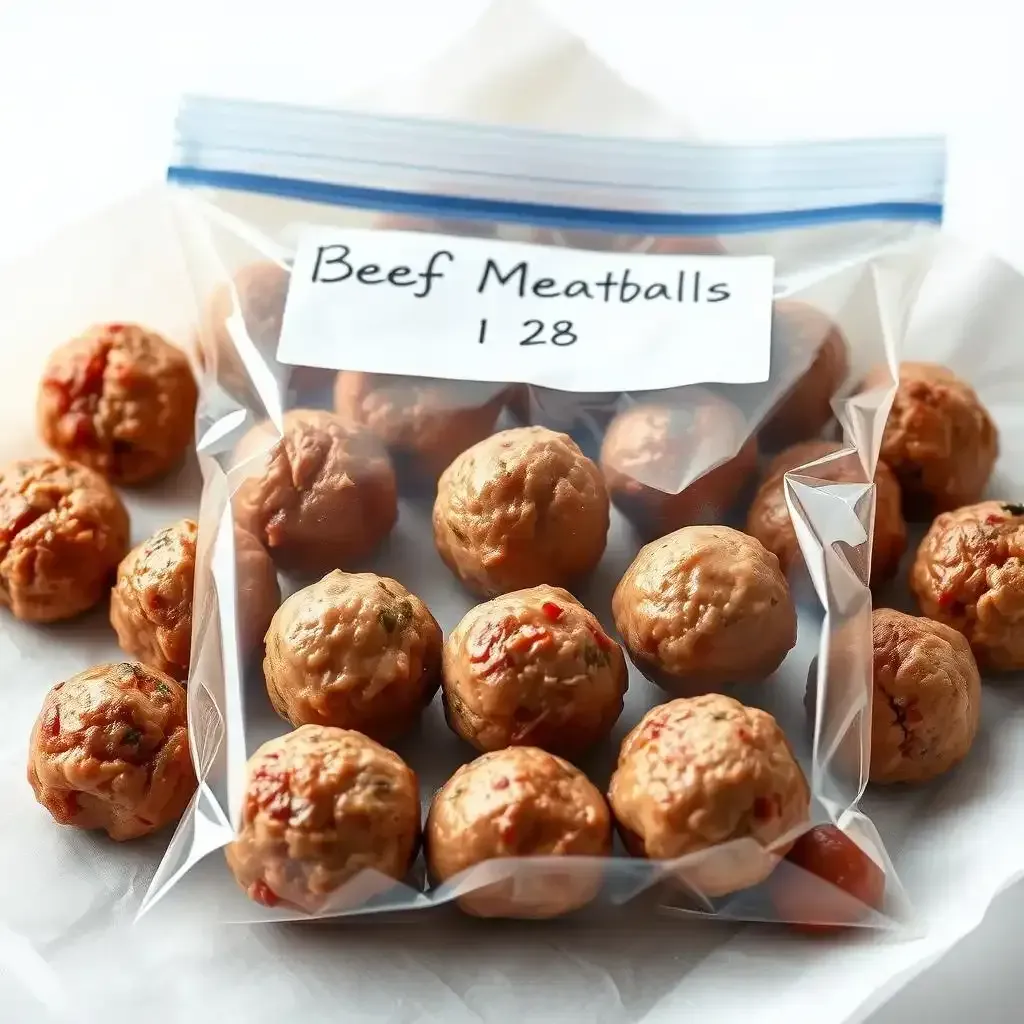Hey meatball lovers! Ever wished you could have delicious homemade beef meatballs on hand whenever the craving hits? Well, you're in luck! freezing beef meatballs is easier than you think, and it's a fantastic way to save time and enjoy those yummy morsels whenever you want. At meatballrecipeskitchen.com, we're all about making your life easier and your meals more delicious, and this guide on freezing beef meatballs will do just that. We'll walk you through every step, from prepping your perfectly seasoned meatballs to storing them correctly so they taste just as amazing months later. Get ready to master the art of freezing beef meatballs and say goodbye to last-minute mealtime stress. So grab your apron, let's examine in and find the simple secrets to freezing beef meatballs!
Freezing Beef Meatballs: The Ultimate Guide

Freezing Beef Meatballs The Ultimate Guide
Hey there, fellow food enthusiasts! Freezing beef meatballs? It's a game-changer, I tell ya! Imagine: a freezer stocked with delicious, homemade meatballs, ready to be tossed into a pasta sauce, added to a hearty soup, or even enjoyed on their own as a tasty snack. It's like having a personal meatball army at your disposal. Seriously, it's awesome. But let's get down to the nitty-gritty. The secret isn't some fancy technique; it's all about getting the prep right. Think of it like this: freezing's like putting your meatballs into a time capsule. You want to make sure they're ready for that long nap in the freezer.
First things first: cook those meatballs completely. Don't even THINK about freezing raw ones—that's a recipe for disaster (and possibly food poisoning!). Once they're cooked to perfection (think perfectly browned and juicy), let them cool completely. This prevents ice crystals from forming and ruining their texture. Imagine trying to eat ice cream that’s been sitting out all day. That's what you want to avoid here.
- Cook your meatballs thoroughly
- Cool them completely before freezing
- Use freezer-safe bags or containers
Next up, the layout. Spread your cooled meatballs out on a baking sheet lined with parchment paper. This ensures they freeze individually, not as one giant meatball brick. Trust me, you'll thank me later when you’re pulling out perfectly portioned meatballs instead of trying to pry apart a frozen lump. Check out our best beef meatballs recipe for some seriously delicious inspiration.
Now, for the freezer. Pop your baking sheet into the freezer for a couple of hours. This flash-freezes the meatballs, preventing them from sticking together. Once they’re solid, you can transfer them to a freezer bag or container. Squeeze out as much air as possible—think of it as giving your meatballs a good hug, removing any excess air. This stops freezer burn, that annoying dryness that can sometimes happen.
Step | Action |
|---|---|
1 | Cook meatballs completely |
2 | Cool completely |
3 | Arrange on parchment paper |
4 | Flash freeze |
5 | Transfer to bag/container |
Label your bag or container with the date. This is super important—you don't want to be digging around in the freezer trying to guess how old your meatballs are. A good rule of thumb is to use them within 3-4 months for the best quality. Need more ideas? Check out our beef meatballs with pasta recipe.
And there you have it! Freezing beef meatballs is easier than you thought, right? You’ve now got a stash of deliciousness ready to go whenever you need it. It's like having a secret weapon in your kitchen. It’s a great way to save time and money. Don't forget to check out our other amazing recipes on meatballrecipeskitchen.com.
Prepping Your Meatballs for Freezing Success

Prepping Your Meatballs For Freezing Success
Okay, so you've decided to join the amazing world of frozen beef meatballs – smart move! Think of it like this: you're creating a meatball time machine, sending deliciousness to the future. But to do this right, we need to get the meatballs ready for their cryogenic slumber. First, and this is crucial, make sure those meatballs are fully cooked. We're talking perfectly browned, juicy perfection. No half-measures here! Imagine trying to freeze a raw cookie dough – it wouldn’t be pretty, and it certainly wouldn't taste good. Freezing raw meatballs is a similar recipe for disaster (and potentially, tummy troubles!).
Once your meatballs are cooked through, let them cool completely. This is like letting your superhero recharge before their next mission. Cooling prevents ice crystals from forming inside the meatballs, which can make them mushy and unpleasant to eat. Nobody wants a mushy meatball! For extra flavor, you might consider checking out our before you get started. It’s a real winner!
- Cook your meatballs until they're fully cooked through.
- Let them cool completely before you even think about freezing.
- Use freezer-safe bags or containers – this is important.
Next, you need to prep your meatballs for individual freezing. Imagine freezing grapes as one giant clump versus freezing them individually. The difference is night and day! So, spread your cooled meatballs in a single layer on a baking sheet lined with parchment paper. This way, they freeze individually, not as one giant, difficult-to-separate meatball brick. You’ll thank me later when you're easily grabbing perfectly portioned meatballs instead of wrestling with a frozen meatball monolith. For some extra inspiration, check out our – it's a classic for a reason!
This next step is super important, it's the flash-freeze! It's like giving your meatballs a superhero strength-up before they go into their time capsule! Pop your baking sheet into the freezer for a couple of hours. This rapid freezing prevents the meatballs from sticking together. Once they're solid, you can move them to a freezer-safe bag or container. Squeeze out as much air as possible – think of it as giving your meatballs a big, meaty hug, removing any extra air. This prevents freezer burn, that annoying dryness that can make your meatballs less delicious.
Step | What to Do |
|---|---|
1 | Cook meatballs completely |
2 | Cool completely on a wire rack |
3 | Arrange on parchment paper |
4 | Flash freeze (1-2 hours) |
5 | Transfer to bag/container |
Freezing Beef Meatballs: Tips, Tricks, and Troubleshooting
Vacuum Sealing: The Secret Weapon
Hey there, meatball mavens! So, you've got your perfectly cooked and cooled meatballs, all ready for their freezer journey. But here's a pro tip that'll seriously level up your freezing game: vacuum sealing. Think of it like this: regular freezer bags are like leaving your meatballs out in the open—exposed to the elements. Vacuum sealing is like giving them a super-protective, airtight suit. It keeps out all that pesky freezer burn, that dry, crusty stuff that nobody wants on their meatballs. Plus, it extends their shelf life, so you can enjoy those delicious morsels for even longer! Vacuum sealers aren't too expensive these days, and they're a fantastic investment if you're a serious freezer-food enthusiast. If you're not ready to invest in a vacuum sealer, you can still get great results by using freezer bags and squeezing out as much air as possible before sealing. Just make sure you get all the air out!
- Use a vacuum sealer for ultimate freezer protection
- Squeeze out all the air if you're using freezer bags
- Label your bags with the date for easy tracking
Thawing and Reheating: The Perfect Comeback
Alright, so your meatball army has been patiently awaiting its deployment from the freezer. How do you bring them back to their former glory? The best way to thaw your frozen meatballs is overnight in the refrigerator. Think of it as a gentle awakening, not a sudden shock to the system. This slow thaw helps maintain their juicy texture. If you're short on time, you can also thaw them quickly in a bowl of cold water, changing the water every 30 minutes. Or, if you're truly in a rush, you can cook them straight from frozen, but they'll take a bit longer to cook through. For reheating, you can pop them back in the oven, microwave them, or even toss them into a simmering sauce. For more ideas on tasty beef recipes, check out our . They're a real crowd-pleaser!
Thawing Method | Time | Best For |
|---|---|---|
Refrigerator | Overnight | Maintaining texture |
Cold Water | 30-60 minutes | Quick thaw |
From Frozen | Longer cooking time | Emergency situations |
Troubleshooting: When Things Go Wrong (and How to Fix Them)
Let’s be honest, sometimes things don't go exactly to plan. Maybe your meatballs got a little freezer burn, or maybe they stuck together more than you'd like. Don't despair! A little freezer burn is usually just cosmetic, and it won't affect the taste. Just trim off the affected parts. If your meatballs stuck together, you can gently separate them while they’re still partially frozen. If they're totally frozen solid, let them thaw slightly before attempting to separate them. Want to avoid these issues altogether? Make sure your meatballs are completely cool before freezing and that you've removed as much air as possible from the bag. For more amazing meatball recipes, check out our —it's a family favorite!
Remember, freezing beef meatballs is a trip, not a race! Don't be afraid to experiment and find what works best for you. With a little practice, you’ll be a meatball-freezing pro in no time. The key is patience and attention to detail. And hey, even if a few things go wrong, you can always make more meatballs—and freeze those too!
"The best things in life are worth waiting for, including perfectly thawed meatballs!" - Me (probably)
Final Thought
Freezing beef meatballs is a simple yet effective way to enjoy homemade goodness whenever you want. By following these steps and tips, you can ensure your meatballs stay delicious and safe to eat for months. So go ahead, make a big batch, freeze them, and enjoy the convenience and flavor of perfectly preserved beef meatballs anytime the urge strikes! Happy cooking!